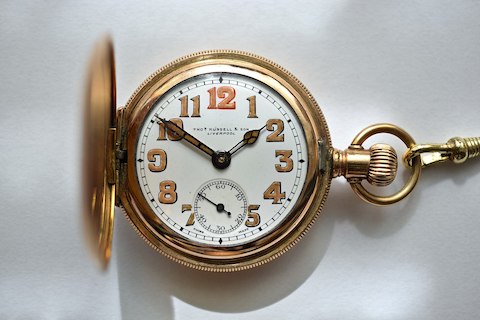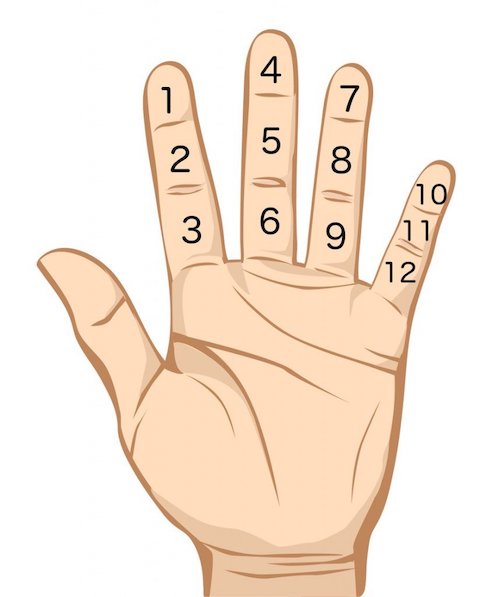
Credit: ElooKoN (CC BY-SA)
We have 10 fingers, so we’ve based our common counting systems on 10. Why then, do we divide the day into 12 hours and the hour into 60 minutes?
To understand, we need to go back 3000 years. Babylonians also used their hands to count, but wanting to count higher than 10, they devised a different system.
They used their thumb to count the three segments of their four fingers to get 12. They marked that 12 by raising a finger on the other hand. Twelve times five fingers is 60.
2500 years ago, when people started using sundials, it seemed only natural to divide the day in 12.
Egyptian astronomers then found 12 stars to mark the passing of time in the night sky, making a 24-hour cycle.
Early Greek mathematicians realized they could divide a circle into six equilateral triangles like a sliced pizza.
Around 2200 years ago, the first Greek astronomer to describe a round Earth wanted a system to navigate it. He took that 6-part circle and divided each part by 60 to get 360 degrees.
Another Greek divided those degrees further, into 60 minute parts, and those into 60 secondary parts.
A few centuries later, these geographic minutes and seconds were applied to the 24-hour day.
But it would take another thousand years before we could accurately measure that second, which we’ll cover on another EarthDate.
Background
Synopsis: Humans have both English and metric systems of measurement for just about everything else, but thankfully it is universally agreed on that a day has 24 hours, an hour has 60 minutes, and a minute has 60 seconds. With our 10 fingers and 10 toes, we tend to operate in the base-10 world, so why are hours organized in multiples of 12 and minutes and seconds divided into 60?
- Early civilizations like the Babylonians (1894–539 BC) used duodecimal (base-12) and sexagesimal (base-60) systems for a very practical reason: accounting.
- Instead of counting on their fingers and toes, ancient bookkeepers used the segments of their fingers to count, tapping the sections between joints with their thumb. Four fingers with 3 segments between the joints made 12.
- Using the five fingers of the other hand to count successive twelves, they could count up to 60 on two hands.
- Sixty is divisible by all integers up to six, so fractions did not pose a problem: 60 ÷ 1 = 60, 60 ÷ 2 = 30, 60 ÷ 3 = 20, 60 ÷ 4 = 15, 60 ÷ 5 = 12, and 60 ÷ 6 = 10.

Credit: ScienceABC
- A day is defined as the time it takes Earth to spin once on its axis. It is divided into 24 hours.
- Egyptians divided the day into two opposing entities: daytime and nighttime.
- As long ago as 1500 BC, they used sundials to divide the day into 12 parts which changed in length as the length of the day changed seasonally. Longer summer days had hours that were longer than winter hours.
- Around the same time, Egyptian astronomers delineated a set of 36 stars that divided the heavens equally. Half of these defined the night, with 3 visible during dusk and 3 visible during dawn, leaving 12 to be used to divide the full darkness of night. Later on, they redefined their system to use a total of 24 stars—12 for the night.
- With 12 divisions of daytime and 12 of nighttime, the 24-hour day was set, but the hours were not the same length between nighttime and daytime, and their lengths varied from day to day.
- Between 147 and 127 BC, the Greek astronomer Hipparchus proposed setting the length of the hour based on the equal length days and nights that occur on the equinox, but common people continued to use hours that varied with the season because they still depended on sundials.
- Fixed length hours didn’t catch on with the general public until the advent of mechanical clocks more than 15 centuries later, in Europe.
- Hours are divided into 60 minutes, and minutes are divided into 60 seconds, but they didn’t start out that way.
- Early mathematicians, geographers, and astronomers realized that circles could be circumscribed around six equilateral triangles arranged like pie slices.
- Around 200 BC, Eratosthenes divided each of the 6 pie slices into 10 parts. He was one of the first to describe a round Earth and he needed a way to describe coordinates for navigation.
- About 60–70 years later, Hipparchus divided each slice into 60 degrees to more precisely describe geography, resulting in the 360-degree circle.
- In his 150 AD treatise Almagest, Ptolemy subdivided each geographical degree into two successive tiers of even smaller segments.
- The first division created 60 partes minutae primae, which were called minutes.
- The minute was further divided into 60 partes minutae secundae, which we know as seconds.
- Early mathematicians, geographers, and astronomers realized that circles could be circumscribed around six equilateral triangles arranged like pie slices.

Credit: Robert Coolman
- It took another couple of centuries for hours to be divided into minutes and seconds.
- Early divisions of hours were 30-minute halves, 20-minute thirds, 15-minute quarters, and 5-minute twelfths.
- Persian scholars first employed minutes and seconds in the 11th century as they used astronomical measurements in degrees, minutes, and seconds to calculate the timing of the appearance of new moons.
- For most, the minute was too fine a division to be used until mechanical clocks came along in the early 14th century, but these were cumbersome machines.
- The 1656 invention of the pendulum clock made timekeeping technology more available to the public, with the pendulum counting down 60 seconds in a minute.
- Each day has 24 × 60 = 1440 minutes, or 24 × 60 × 60 = 86,400 seconds.
- Ironically, with modern precision calculation and instrumentation, seconds have been further divided—using base-10 this time—into milliseconds (thousandths), microseconds (millionths), and nanoseconds (billionths of a second).
- These precise time units pose a new problem for scientists: they need to be a constant duration.
- We know from a previous EarthDate that Earth’s days are getting longer as the moon slows Earth’s rotation, so if the length of days is changing, and a second is defined as 1/86,400th of a day, then the length of seconds is changing too.
- In our next EarthDate episode, we’ll explain how in 1967, modern metrologists solved this conundrum.

